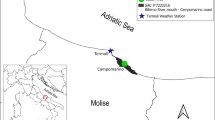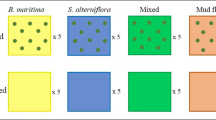Abstract
The South American cordgrass Spartina densiflora is invading European salt marshes getting into contact with the indigenous and endangered low-marsh dominant, Spartina maritima. This work describes the evolution of the plant zonation during 7 years in a marsh of S. maritima invaded by S. densiflora. S. maritima appeared throughout the whole intertidal gradient from 1.72 to 3.33 m over Spanish Hydrographic Zero (SHZ), showing its higher biomasses and shoot densities at low elevations. In contrast, S. densiflora only invaded upper areas (>+2.59 m SHZ) at the centre of circular tussocks of S. maritima. Above-ground biomass of S. maritima dropped drastically at maximum occupation of space by the alien, and its shoot density and above-ground biomass decreased at S. densiflora zone during the study. The competitive potential of S. densiflora was reflected in high above- and below-ground biomass and shoot densities, accompanied by elevated wrack accumulation and the absence of other marsh plants presented together with S. maritima from areas dominated by S. densiflora. S. densiflora altered the native vegetational zonation pattern through the invasion of the centre of S. maritima tussocks; however, the alien invasion may be limited by the presence of the autochthonous cordgrass at lower elevations.




Similar content being viewed by others
References
Ayres, D. R., D. G. Rossi, H. G. Davis & D. R. Strong, 1999. Extent and degree of hybridization between exotic (Spartina alterniflora) and native (S. foliosa) cordgrass (Poaceae) in California, USA determined by random amplified DNA (RAPDs). Molecular Biology 8: 1179–1186.
Benito, I. & M. Onaindia, 1991. Biomass and aboveground production of 4 angiosperms in Cantabrian (n. Spain) salt marshes. Vegetatio 96: 165–175.
Bertness, M. D., 1991. Zonation of Spartina patens and Spartina alterniflora in a New England salt marsh. Ecology 72: 138–148.
Bortolus, A., 2006. The austral cordgrass Spartina densiflora Brong.: its taxonomy, biogeography and natural history. Journal of Biogeography 33: 158–168.
Brewer, J. S., 2003. Nitrogen addition does not reduce belowground competition in a salt marsh clonal plant community in Mississippi (USA). Plant Ecology 168: 93–106.
Bueno, A., 1997. Flora y vegetación de los estuarios asturianos. Cuadernos de Medio Ambiente. Naturaleza 3. Consejería de Agricultura, Principado de Asturias, Asturias, Spain.
Cabezudo, B., S. Talavera, G. Blanca, C. Salazar, M. Cueto, B. Valdés, J. E. Hernández-Bermejo, C. M. Herrera, C. Rodríguez-Hiraldo & D. Navas, 2005. Lista roja de la flora vascular de Andalucía. Consejería de Medio Ambiente, Junta de Andalucía, Seville, Spain.
Castellanos, E. M., M. E. Figueroa & A. J. Davy, 1994. Nucleation and facilitation in saltmarsh succession: interactions between Spartina maritima and Arthrocnemum perenne. Journal of Ecology 82: 239–248.
Castellanos, E. M., C. Heredia, M. E. Figueroa & A. J. Davy, 1998. Tiller dynamics of Spartina maritima in successional and non-successional Mediterranean salt marsh. Plant Ecology 137: 213–225.
Castillo, J. M., L. Fernández-Baco, E. M. Castellanos, C. J. Luque, M. E. Figueroa & A. J. Davy, 2000. Lower limits of Spartina densiflora and S. maritima in a Mediterranean salt marsh determined by differential ecophysiological tolerances. Journal of Ecology 88: 801–812.
Castillo, J. M., A. E. Rubio-Casal, T. Luque, M. E. Figueroa & F. J. Nieva, 2003. Intratussock tiller distribution and biomass of Spartina densiflora Brongn. in an invaded salt marsh. Lagascalia 23: 61–73.
Castillo, J. M., A. E. Rubio-Casal, S. Redondo, A. A. Álvarez-López, T. Luque, C. Luque, F. J. Nieva, E. M. Castellanos & M. E. Figueroa, 2005a. Short-term responses to salinity of an invasive cordgrass. Biological Invasions 7: 29–35.
Castillo, J. M., S. Redondo, C. Wharmby, M. E. Figueroa, E. M. Castellanos, T. Luque & A. J. Davy, 2005b. Environmental determination of shoot height in populations of the cordgrass Spartina maritima. Estuaries 28: 761–766.
Chen, Z. Y., B. Li, Y. Zhong & J. K. Cheng, 2004. Local competitive effects of introduced Spartina alterniflora on Scirpus mariqueter at Dongtan of Chongming Island, the Yangtze River estuary and their potential ecological consequences. Hydrobiologia 528: 99–106.
Cooper, M. A., 1993. The status of Spartina maritima in Suffolk. Transactions of the Suffolk Natural Society 29: 48–54.
Craft, C., J. Reader, J. N. Sacco & S. W. Broome, 1999. Twenty-five years of ecosystem development of created Spartina alterniflora (Loisel) marshes. Ecological Applications 9: 1405–1419.
Craft, C., S. Broome & C. Campbell, 2002. Fifteen years of vegetation and soil development after brackish-water marsh creation. Restoration Ecology 10: 248–258.
Craft, C., P. Megonigal, S. Broome, J. Stevenson, R. Freese, J. Cornell, L. Zheng & J. Sacco, 2003. The pace of ecosystem development of created Spartina alterniflora marshes. Ecological Applications 13: 1417–1432.
Ewanchuk, P. J. & M. D. Bertness, 2004. Structure and organization of a northern New England salt marsh plant community. Journal of Ecology 92: 72–85.
Figueroa, M. E. & E. M. Castellanos, 1988. Vertical structure of Spartina maritima and Spartina densiflora in Mediterranean marshes. In Werger, M. J. A., P. J. M. van der Aart, H. J. During & J. T. A. Verhoeven (eds), Plant form and vegetation structure. SPB Academic Publishing, The Hague: 105–108.
Figueroa, M. E., J. M. Castillo, S. Redondo, T. Luque, E. M. Castellanos, F. J. Nieva, C. J. Luque, A. E. Rubio-Casal & A. J. Davy, 2003. Facilitated invasion by hybridization of Sarcocornia species in a salt-marsh succession. Journal of Ecology 91: 616–626.
Isacch, J. P., C. S. B. Costa, L. Rodriguez-Gallego, D. Conde, M. Escapa, D. A. Gagliardini & O. O. Iribarne, 2006. Distribution of saltmarsh plant communities associated with environmental factors along a latitudinal gradient on the south-west Atlantic coast. Journal of Biogeography 33: 888–900.
Kittelson, P. M. & M. J. Boyd, 1997. Mechanisms of expansion for an introduced species of cordgrass, Spartina densiflora, in Humboldt Bay, California. Estuaries 20: 770–778.
Lillebo, A. I., M. R. Flindt, M. A. Pardal & J. C. Marques, 2006. The effect of Zostera noltii, Spartina maritima and Scirpus maritimus on sediment pore-water profiles in a temperate intertidal estuary. Hydrobiologia 555: 175–183.
Nieva, F. J., E. M. Castellanos, M. E. Figueroa & F. Gil, 1999. Gas exchange and chlorophyll fluorescence of C3 and C4 saltmarsh species. Photosynthetica 36: 397–406.
Nieva, F. J., A. Diaz-Espejo, E. M. Castellanos & M. E. Figueroa, 2001. Field variability of invading populations of Spartina densiflora Brong. grown in different habitats of the Odiel marshes (SW Spain). Estuarine, Coastal and Shelf Science 52: 515–527.
Nieva, F. J. J., J. M. Castillo, C. J. Luque & M. E. Figueroa, 2003. Ecophysiology of tidal and non-tidal populations of the invading cordgrass Spartina densiflora: seasonal and diurnal patterns in Mediterranean climate. Estuarine. Coastal and Shelf Science 57: 1–10.
Nieva, F. J. J., E. M. Castellanos, J. M. Castillo & M. E. Figueroa, 2005. Clonal growth and tiller demography of the invader cordgrass Spartina densiflora Brongn at two contrasting habitats in SW European salt marshes. Wetlands 25: 122–129.
Pennings, S. C. & R. M. Callaway, 1992. Salt marsh zonation: the relative importance of competition and physical factors. Ecology 73: 681–690.
Pennings, S. C., M. B. Grant & M. D. Bertness, 2005. Plant zonation in low-latitude salt marshes: disentangling the roles of flooding, salinity and competition. Journal of Ecology 93: 159–167.
Ranwell, D. S., E. C. F. Bird, J. C. R. Hubbard & R. E. Stebbings, 1964. Spartina salt marshes in Southern England. V. Tidal submergence and chlorinity in Poole Harbour. Journal of Ecology 52: 627–641.
SanLeon, D. G., J. Izco & J. M. Sanchez, 1999. Spartina patens as a weed in Galician saltmarshes (NW Iberian Peninsula). Hydrobiologia 415: 213–222.
Silliman, B. R. & M. D. Bertness, 2004. Shoreline development drives invasion of Phragmites australis and the loss of plant diversity on New England salt marshes. Conservation Biology 18: 1424–1434.
Tolley, P. M. & R. R. Christian, 1999. Effects of increased inundation and wrack deposition on a high salt marsh plant community. Estuaries 22: 944–954.
Ungar, I. A., 1998. Are biotic factors significant in influencing the distribution of halophytes in saline habitats? The Botanical Review 64: 176–199.
Van Hulzen, J. B., J. Van Soelen & T. J. Bouma, 2007. Morphological variation and habitat modification are strongly correlated for the autogenic ecosystem engineer Spartina anglica (Common cordgrass). Estuaries and Coasts 30: 3–11.
Vicari, R. L., S. Fischer, N. Madanes, S. M. Bonaventura & V. Pancotto, 2002. Tiller population dynamics and production on Spartina densiflora (Brong) on the floodplain of the Parana River, Argentina. Wetlands 22: 347–354.
Acknowledgements
We thank the Spanish Science and Technology Ministry for their support (project no. REN2002-00340/MAR). This study was carried out through an investigation agreement with the General Directorate of Environmental Protection of the Junta de Andalucía. We also thank the Directorate of the Odiel Marshes Natural Park for collaboration and S. Redondo for her comments.
Author information
Authors and Affiliations
Corresponding author
Additional information
Handling editor: Luis Mauricio Bini
Rights and permissions
About this article
Cite this article
Castillo, J.M., Mateos-Naranjo, E., Nieva, F.J. et al. Plant zonation at salt marshes of the endangered cordgrass Spartina maritima invaded by Spartina densiflora . Hydrobiologia 614, 363–371 (2008). https://doi.org/10.1007/s10750-008-9520-z
Received:
Revised:
Accepted:
Published:
Issue Date:
DOI: https://doi.org/10.1007/s10750-008-9520-z




